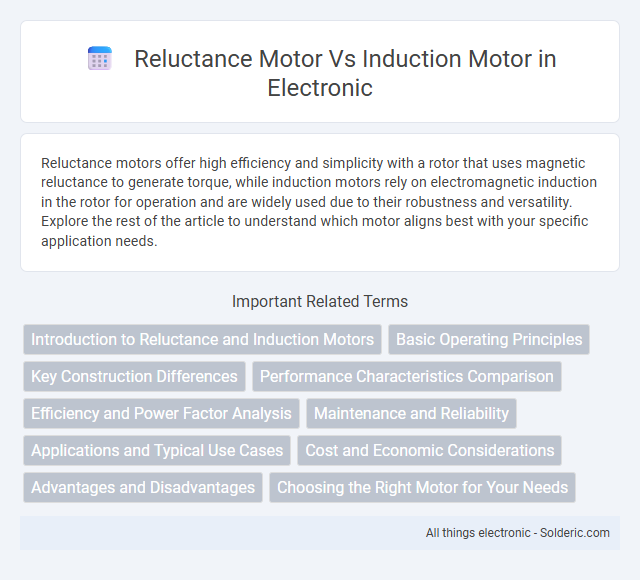Reluctance motors offer high efficiency and simplicity with a rotor that uses magnetic reluctance to generate torque, while induction motors rely on electromagnetic induction in the rotor for operation and are widely used due to their robustness and versatility. Explore the rest of the article to understand which motor aligns best with your specific application needs.
Comparison Table
| Feature | Reluctance Motor | Induction Motor |
|---|---|---|
| Operating Principle | Magnetic reluctance variation | Electromagnetic induction |
| Rotor Construction | Salient poles, no winding | Copper/aluminum squirrel cage or wound |
| Starting Torque | Low to moderate | High |
| Efficiency | Moderate | High |
| Speed Control | Easy, precise with inverter | Moderate, via frequency variation |
| Maintenance | Low (no brushes or slip rings) | Low to moderate (depends on rotor type) |
| Applications | Positioning, servo drives | Pumps, fans, compressors, general purpose |
| Cost | Lower rotor cost, overall moderate | Generally low and mass-produced |
Introduction to Reluctance and Induction Motors
Reluctance motors operate by exploiting the magnetic reluctance difference in the rotor path, producing torque through the rotor's tendency to align with the stator's rotating magnetic field, making them energy-efficient and uniquely suited for precise control applications. Induction motors function by inducing an electric current in the rotor via electromagnetic induction from the stator, offering robustness, simplicity, and widespread industrial use due to their reliable operation under various load conditions. Understanding these fundamental operating principles can help you select the optimal motor type for your specific performance and efficiency requirements.
Basic Operating Principles
Reluctance motors operate based on the principle of magnetic reluctance, where the rotor aligns to minimize magnetic resistance in the stator's magnetic field, resulting in torque production through variable reluctance. Induction motors function by inducing current in the rotor conductors via electromagnetic induction from the stator's rotating magnetic field, generating torque due to the interaction of these currents with the magnetic field. Understanding these distinct basic operating principles helps you choose between the two motors for applications requiring specific efficiency, speed control, or torque characteristics.
Key Construction Differences
Reluctance motors feature a rotor with salient poles and no windings or permanent magnets, making it simpler and lighter compared to the squirrel-cage design of an induction motor's rotor. Induction motors rely on induced currents in the rotor bars, whereas reluctance motors depend on the rotor's tendency to align with the rotating magnetic field to generate torque. Understanding these key construction differences helps you choose the appropriate motor for applications requiring high efficiency and robustness.
Performance Characteristics Comparison
Reluctance motors exhibit higher efficiency and better speed regulation under varying loads compared to induction motors, which tend to have simpler construction but lower power factor. You can expect reluctance motors to deliver improved torque density and reduced rotor losses, making them ideal for precise control applications. Induction motors generally provide robust performance and cost-effectiveness but lag behind in dynamic response and energy efficiency metrics relative to reluctance motors.
Efficiency and Power Factor Analysis
Reluctance motors exhibit higher efficiency at lower speeds due to reduced rotor losses, while induction motors generally maintain consistent efficiency across a broader speed range. The power factor of reluctance motors improves with load because of their synchronous operation, contrasting with induction motors that often suffer from lower power factors under light load conditions. Efficiency and power factor considerations make reluctance motors preferable in applications requiring precise speed control and energy savings.
Maintenance and Reliability
Reluctance motors generally require less maintenance than induction motors due to their simple rotor construction without windings or permanent magnets, reducing wear and failure points. Induction motors, while robust and widely used, demand regular inspection of the rotor bars and bearings to ensure reliable operation and prevent downtime. Reliability in reluctance motors is enhanced by fewer mechanical components, whereas induction motors benefit from established fault diagnosis techniques and extensive maintenance protocols.
Applications and Typical Use Cases
Reluctance motors are preferred in applications requiring high efficiency and precise position control, such as robotics, aerospace actuators, and servo drives, due to their simple construction and robust performance. Induction motors dominate industrial environments including pumps, conveyors, fans, and compressors, benefiting from their durability, cost-effectiveness, and ease of maintenance. Both motor types serve distinct roles, with reluctance motors excelling in variable speed and load conditions, while induction motors are favored for continuous, high-power operations.
Cost and Economic Considerations
Reluctance motors typically offer lower initial costs due to simpler rotor construction without windings or permanent magnets, reducing material expenses. Induction motors, while slightly more expensive upfront, benefit from widespread manufacturing and established supply chains, contributing to lower maintenance costs and longer operational lifespans. Economic considerations favor reluctance motors in applications requiring cost efficiency and simplicity, whereas induction motors provide better value in heavy-duty, high-reliability scenarios.
Advantages and Disadvantages
Reluctance motors offer advantages such as high efficiency, simple construction, and robustness, making them ideal for applications requiring precise speed control and low maintenance. However, they suffer from torque ripple and vibration issues, limiting their performance at high speeds compared to induction motors, which provide smooth torque and reliable operation in a wide range of industrial settings. Induction motors have the disadvantage of lower efficiency and higher energy consumption but benefit from widespread availability and established technology.
Choosing the Right Motor for Your Needs
Reluctance motors offer high efficiency and robust performance in applications requiring precise speed control, making them ideal for energy-sensitive and variable-load environments. Induction motors provide reliable, cost-effective operation with simple construction, suiting heavy-duty industrial tasks and general-purpose use where robustness is key. Selecting the right motor depends on factors such as load characteristics, efficiency demands, control complexity, and budget constraints.
Reluctance motor vs induction motor Infographic

 solderic.com
solderic.com